
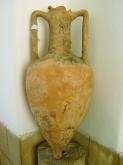
{image_1} Acting on specific intelligence, the Theft Prevention Unit of the Israel Antiquities Authority (IAA) raided a home in Haifa recently where they discovered several hundreds of items, some of them unique and very valuable. According to the IAA, the items had been either stolen or acquired illegally and were going to be smuggled out of the country for sale abroad.
Continue Reading »
{image_1} The Jewish National Fund gave the Adulam Park to the State of Israel for its 60th anniversary, as reported in the Good News section of the last Dispatch from Jerusalem, the Jewish National Fund gave the Adulam Park to the State of Israel for its 60th anniversary. Since then, we have received further information about the park. Located near the Valley of Elah, where David fought Goliath, the park covers some 50,000 dunams (12,500 acres) and will be developed with bike and hiking trails and other outdoor activities.
Continue Reading »
{image_1} In 2007, Reich and Shukron found part of a Second Temple Period street and a channel that ran beside it, showing evidence of people having lived inside for some time. The channel was deliberately broken in several places where the Roman soldiers penetrated under the streets to capture and kill Jewish people hiding there, confirming the account by Flavius Josephus of the destruction of Jerusalem in AD 70.
Continue Reading »
{image_1} An inscription from the First Temple Period was found recently by Professor Ronny Reich of Haifa University and Eli Shukron of the Israel Antiquities Authority (IAA) in their excavations near the Siloam Pool at the southern tip of the City of David. According to Reich, “We can date it to the eighth century BC through the shape of the letters and the pottery with which it was found.” Reich said that the inscription consisted of only six Hebrew letters found on several 2 to 3-inch (5 to 7.6-centimeter) fragments of white stone that was “broken from all sides.” He also said that it was still too early to know exactly what the inscription is and that more fragments would need to be found. However, Reich did agree that inscriptions from this period are indeed rare.
Continue Reading »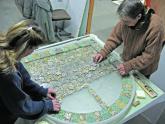
{image_1}The Israel Antiquities Authority (IAA) recently unveiled a large 103 x 103 centimeter (40.5 x 40.5 inch) glass panel first discovered in 2005. The panel was found in Caesarea in the ruins of a large Byzantine Period (AD 324–638) structure, possibly a palace. It was found face down underneath the collapsed second floor of the structure. Specialists have spent the last several years restoring and studying the panel.
Continue Reading »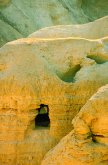
“Archaeology in Israel has provided a valuable link between the country’s past and present, with thousands of years of history unearthed at some 3,500 sites. Many finds attest to the long connection of the Jewish people with the Land of Israel,” states Israel’s Ministry of Foreign Affairs. While Muslims are busy destroying thousands of years of Jewish history below the Temple Mount, archaeological finds in the past 60 years throughout Israel have only reaffirmed Israel’s claim to the Land. We have room to highlight only three.
Continue Reading »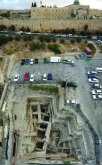
{image_1}One of the biggest problems in Jerusalem is finding a place to park. Each year the city attracts hundreds of thousands of visitors, and one of the most popular destinations is the Western Wall below the Temple Mount. The city of Jerusalem decided to build a new parking lot for visitors to the Western Wall near the entrance to the City of David, but before work could begin, archaeologists undertook a salvage dig to see if there were any antiquities there.
Continue Reading »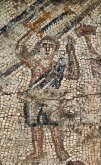
{image_1}The remains of a synagogue believed to be from the Late Roman Period (AD 135–324) were recently discovered in excavations at Khirbet Wadi Hamam. Located about 5 kilometers (3.1 miles) north of Tiberias in the Galilee, the site is being excavated under the direction of Dr. Uzi Leibner of the Hebrew University of Jerusalem.
Continue Reading »
{image_1}The laying of a new electrical line on the Temple Mount this summer (see article on page 9) allowed Israel Antiquities Authority (IAA) inspectors to discover a layer containing finds dating to the First Temple era. Jon Seligman, IAA Jerusalem district archeologist, said that the discovery—mostly ceramics and a few bones—was made while inspecting the construction work. Unfortunately, no full excavation was conducted, and no further archaeological work is planned for the future, as it is a prayer site for the Muslims.
Continue Reading »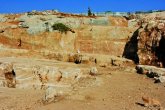
{image_1}A large 1.23-acre quarry has been discovered in Ramat Shlomo, a north Jerusalem neighborhood. The Israel Antiquities Authority believes that stones from the quarry were used in the construction of the Second Temple. The stones reach up to 26 feet (7.9 meters) in length and are consistent with stones found in the bottom layers of the walls surrounding the Temple Mount, known to be placed there by King Herod. Several clay objects, tools, and coins found at the site confirm that it was in use during the first century AD, when the new Temple complex was still being built.
Continue Reading »All logos and trademarks in this site are property of their respective owner. All other materials are property of Bridges for Peace. Copyright © 2025.
Website Site Design by J-Town Internet Services Ltd. - Based in Jerusalem and Serving the World.